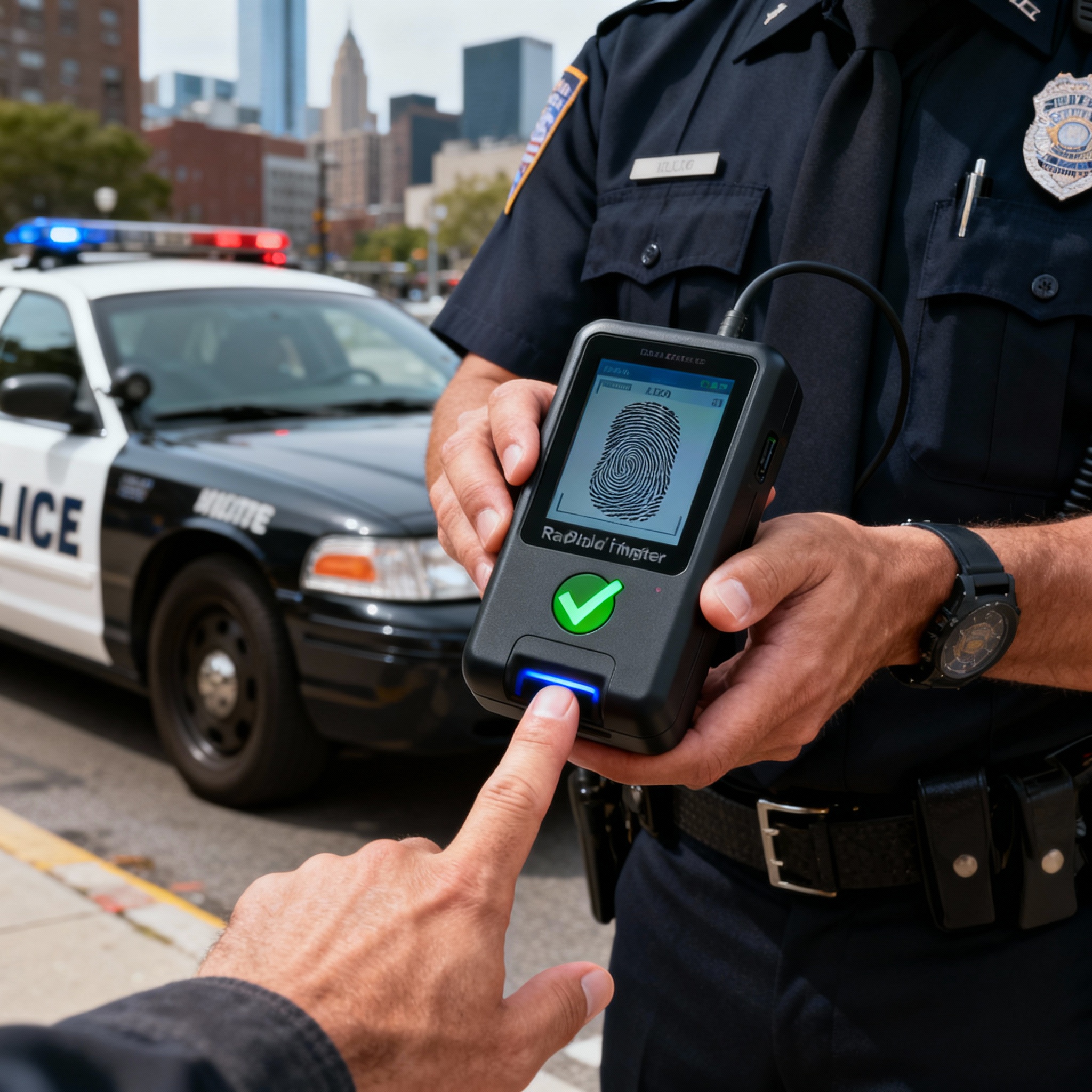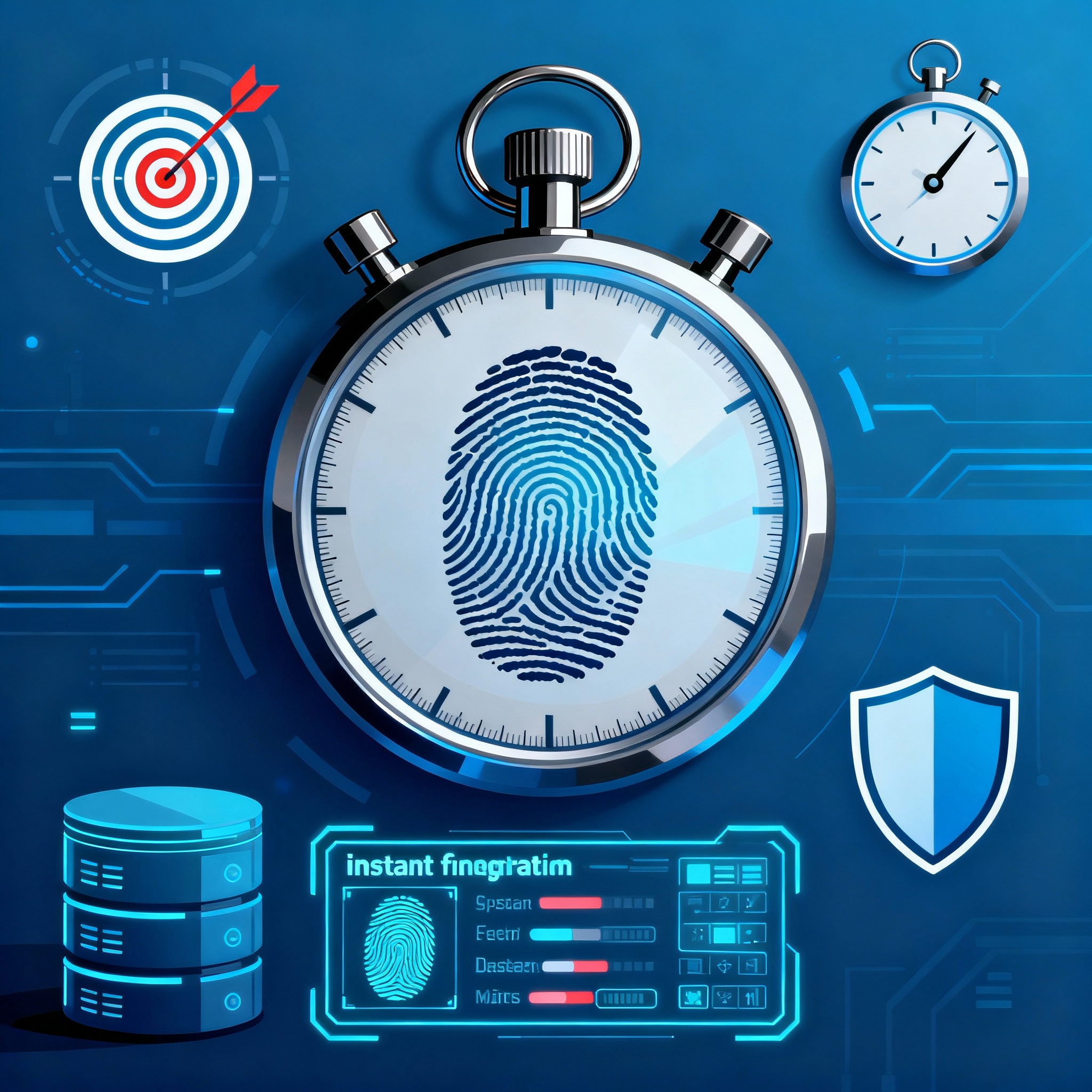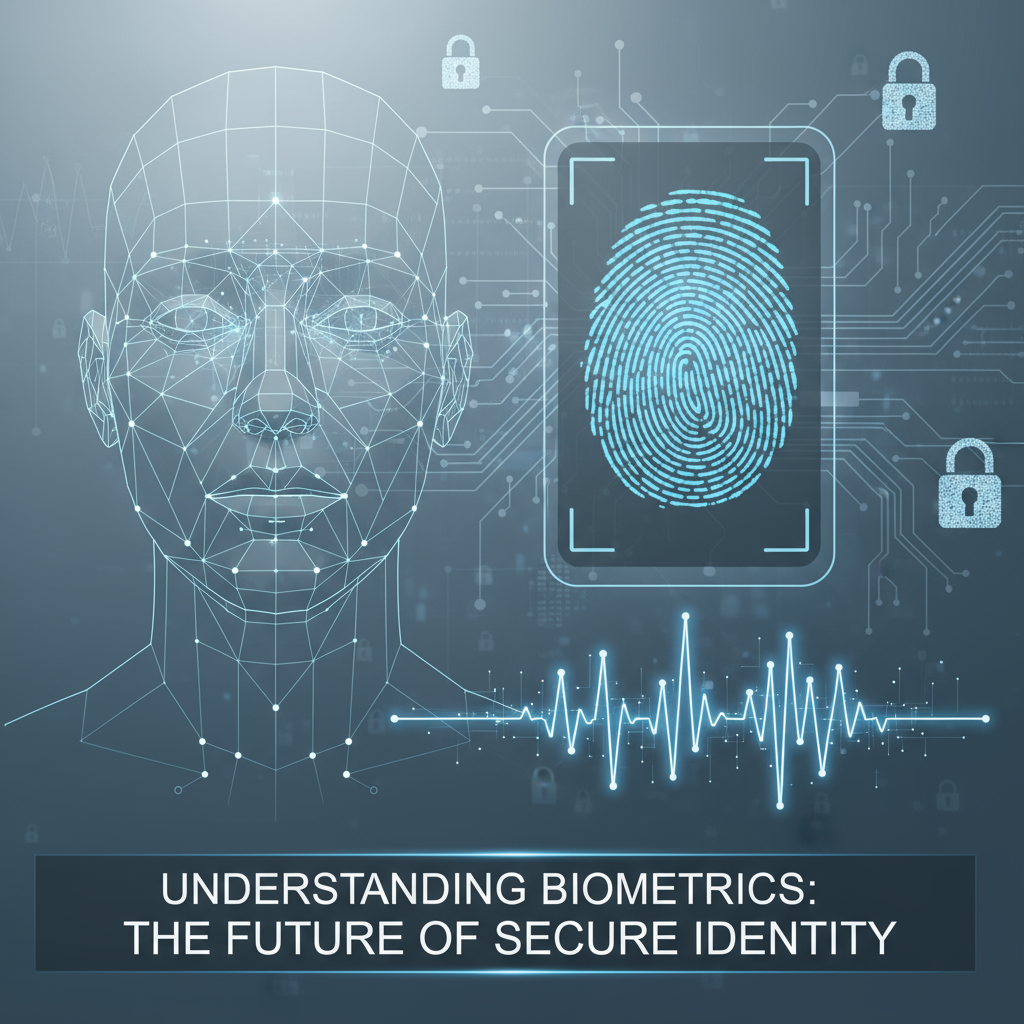Summary
Fingerprint recognition has been a trusted tool for law enforcement for more than a century. Today, rapid fingerprinting technology has transformed how quickly and accurately police can identify individuals, solve cases, and protect communities. With mobile devices and advanced databases, a rapid ID fingerprint scanner can deliver results in less than a minute. This means officers spend less time waiting for identity checks and more time ensuring public safety. In this blog, we explain what fingerprints are used for, why fingerprints are important, and the key benefits of rapid fingerprints for law enforcement agencies.
Biometrics play a central role in modern policing, and fingerprints remain one of the most reliable identifiers. No two people share the same fingerprints, making them a trusted way to confirm identity.
Law enforcement agencies use fingerprinting for multiple tasks, including crime scene investigations, background checks, and criminal record verification. While traditional fingerprinting has helped police for decades, the process was often slow, requiring weeks or months for database matches. This delay affected investigations, family members waiting for justice, and overall community safety.
Today, rapid fingerprinting devices provide faster, more accurate results, changing how police work in the field and in investigations.
Why Fingerprints Are Important

Fingerprints are unique to each person. Even identical twins do not share the same fingerprint patterns. This uniqueness makes them reliable for identifying suspects, victims, and even unconscious individuals.
So, why are fingerprints important?
- They provide proof of identity in criminal cases.
- They link suspects to multiple crime scenes.
- They help build a history of arrests and convictions.
- They are widely accepted in courts as strong evidence.
When officers ask, what are fingerprints used for, the answer is simple: they are used for identification, verification, and connecting individuals to criminal activity.
Challenges with Traditional Fingerprinting
Despite their value, traditional fingerprinting has limitations.
- Collection issues – Fingerprints found at crime scenes can be patent (visible), latent (invisible), or plastic (3D impressions). Latent prints require special techniques to recover, which can delay investigations.
- Slow results – After collection, prints are analyzed and matched with databases. This process may take weeks or months.
- Impact on families and victims – Delays in identification prolong uncertainty for affected families.
- Field identification delays – If someone lacks ID documents, officers may spend hours confirming identity, reducing patrol efficiency.
These challenges highlighted the need for faster, more efficient methods—leading to the rise of rapid fingerprinting solutions.
Rapid Fingerprinting Solutions
Mobile Rapid ID Fingerprint Scanner

Modern devices allow officers to scan fingerprints in the field and receive results within a minute. These portable tools:
- Verify identity instantly against State and Federal databases.
- Detect false identities or confirm if a person has a criminal record.
- Alert officers about outstanding warrants.
- Improve officer safety during suspect encounters.
This rapid ID fingerprint scanner has become one of the most useful technologies for street patrols, traffic stops, and border checks.
Automated Biometric Identification Systems (ABIS/AFIS)
Advanced systems such as AFIS and ABIS give local agencies direct access to national and FBI databases. This eliminates the need to send fingerprints to third-party vendors and wait weeks for results. Instead, police receive faster matches that help them solve cases quickly.
Broader Applications
- Identifying deceased or unconscious individuals whose fingerprints exist in databases.
- Supporting disaster victim identification after accidents or mass casualties.
- Verifying inmate identities in correctional facilities.
What Happens After Police Get a Fingerprint Match?
Many people ask, what happens after police get a fingerprint match? The process is straightforward:
- The match connects the fingerprint to an individual’s record in the database.
- Officers review criminal history, outstanding warrants, and prior offenses.
- Investigators link the suspect to crime scenes where fingerprints were found.
- The information is used for arrests, legal proceedings, and sentencing decisions.
This process is faster and more accurate with rapid fingerprints technology, reducing delays and errors.
Also Read: The Benefits of Biometric Access Control
Benefits of Rapid Fingerprints for Law Enforcement
1. Faster Justice Delivery
Traditional fingerprint processing could take weeks or even months. During that time, suspects might remain free, and families affected by crime were left waiting for answers. With rapid ID fingerprint scanners, identification can happen in under a minute.
- In the field: Officers can scan a suspect’s fingerprints during a routine stop and know instantly if they are wanted.
- In investigations: Crime scene prints can be compared to national databases within hours instead of months.
This speed brings quicker justice to victims, ensures criminals are removed from the streets faster, and improves overall community safety.
2. Stronger Public Safety
Why are fingerprints important for public safety? Because they help confirm whether a person is who they claim to be. Rapid fingerprinting enhances this by giving police real-time alerts about potential threats.
- Officers can confirm if someone has a violent criminal history.
- Warrants can be served on the right individual without mistakes.
- False identities can be detected on the spot.
This ensures dangerous individuals are identified quickly, reducing risks to officers and the community.
3. Improved Operational Efficiency
Traditional fingerprinting drained police resources. Officers often had to escort suspects to a station, process prints, and wait hours or days for results. This reduced time available for patrol duties.
With rapid fingerprints:
- Officers stay in the field and continue their patrols.
- Identity checks are done in minutes, not hours.
- Investigations move forward without long delays.
This efficiency means more officers are present on the streets, improving visibility and deterrence against crime.
4. Cost Savings for Agencies
Delays in fingerprint processing not only slowed justice but also increased costs. Agencies had to rely on third-party vendors or send prints to the FBI, creating expenses and delays.
Rapid fingerprinting reduces costs by:
- Eliminating the need for outsourcing fingerprint analysis.
- Cutting administrative overhead caused by manual verification.
- Preventing long detention periods that increase operational costs.
Over time, these savings allow agencies to allocate budgets to other critical areas like community programs and officer training.
5. Higher Accuracy in Identification
A key advantage of rapid fingerprinting is the accuracy of matches. Fingerprints are nearly impossible to duplicate, making them stronger than passwords or ID cards that can be stolen or forged.
- Rapid ID fingerprint scanners link scans directly to State and Federal databases.
- Matches are verified in real time with minimal error.
- Wrongful arrests caused by mistaken identity are significantly reduced.
This level of accuracy builds stronger legal cases and ensures justice is based on reliable evidence.
6. Better Officer Safety
Law enforcement officers often face uncertain situations. When interacting with unknown individuals, knowing their true identity is critical.
With rapid fingerprints:
- Officers get instant warnings if the person has a history of violence.
- They can approach situations with better preparation.
- Arrests are safer because officers know if the suspect is armed or wanted.
This protection helps officers make informed decisions during encounters.
7. Greater Community Trust
Delays in solving crimes or wrongful arrests can damage public trust. Rapid fingerprinting helps rebuild confidence by showing communities that police can deliver results quickly and fairly.
- Families of victims receive answers sooner.
- Communities see visible progress in solving crimes.
- Transparency improves when results are fast and accurate.
Trust between law enforcement and the public is one of the most valuable outcomes of rapid fingerprinting.
Case Example: AFIX Suite by Aware
The AFIX Suite is one example of how technology supports law enforcement with rapid ID fingerprint scanners and database access. It is affordable, accurate, and deployed in more than 500 sites in the U.S. and 25+ countries. The system allows for:
- Field fingerprint scanning.
- Faster matches against national and international databases.
- Applications in investigations, patrols, and disaster victim identification.
Future of Rapid Fingerprinting
The future of fingerprinting lies in advanced biometrics. Police agencies are expanding from fingerprints to multi-modal identification that includes facial recognition, iris scans, and voice. AI-powered systems will make matches faster and more predictive. However, privacy and ethical considerations will remain critical as adoption grows.
Case Example: AFIX Suite by Aware
One example of rapid fingerprinting solutions is Aware’s AFIX suite, which has been deployed in over 500 sites across the U.S. and more than 25 countries. It offers accurate and affordable biometric identification technology that supports both crime scene investigations and field operations.
Future of Rapid Fingerprinting in Policing
- Integration with multi-modal biometrics (face, iris, voice).
- AI-powered analytics for predictive policing.
- Expansion in smart cities and cross-border security.
- Ethical focus on privacy and responsible data use.
FAQs
What are fingerprints used for in law enforcement?
Fingerprints are used to confirm identity, connect suspects to crime scenes, and maintain criminal records.
Why are fingerprints important?
They are unique to each individual and accepted in courts as reliable evidence.
What is a rapid ID fingerprint scanner?
It is a mobile device that lets officers scan and check fingerprints against databases within a minute.
What happens after police get a fingerprint match?
The match connects a suspect to criminal records, helps confirm warrants, and supports legal processes.
Do rapid fingerprints save time?
Yes, they reduce investigation time from weeks to minutes and allow officers to focus on patrol duties.
Can rapid fingerprinting prevent wrongful arrests?
Yes, by providing precise matches, rapid fingerprinting reduces errors and ensures correct identification.
Conclusion
Rapid fingerprinting has become a critical tool for modern law enforcement. From faster justice and cost savings to improved officer safety and community trust, the benefits are clear. With tools like rapid ID fingerprint scanners and advanced database systems, agencies can deliver accurate results in minutes, making communities safer and more secure.
Debabrata Behera is a passionate blogger who writes about digital trends, personal growth, and practical insights, helping readers stay informed, inspired, and ready to achieve success in life.




